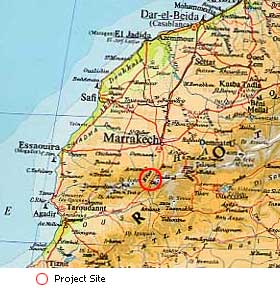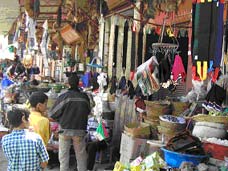|
Morocco
Morocco has particularly high species diversity and endemism, with 3800 vascular plant species, of which 829 are endemic. In rural areas, people rely exclusively upon medicinal plants for healing, as western medicines are relatively expensive.
The project site in Morocco is in and around the Toubkal National Park, Morocco's oldest and most prestigious protected area, situated in the Atlas Mountains at 75 km of Marrakech. The Park contains medium and high altitude mountains, as well as the highest peak of North Africa, the Toubkal (4167 m). There are 130 douhars (hamlets) around Toubkal National Park, and the people in the area rely on medicinal plants for treating illnesses. Medicinal plants are largely overexploited in and around the park, and there is a need to substitute cultivation for wild harvesting.

In Morocco, the Programme is implemented by the Société Protectrice des Animaux et de la Nature, in close collaboration with the Institut Agronomique et Vétérinaire Hassan II, the Faculté de Médecine et de Pharmacie de Rabat, and the Direction régionale des Eaux et Forêts du Haut Atlas, with Prof Abdelhamid Belemlih as the National Coordinator. It aims to promote traditional knowledge on medicinal and aromatic plants and improve revenues from these plants, as well as their rational and sustainable management.
Threatened and endangered medicinal and aromatic plant species in Toubkal National Park have been determined. Species have been classified according to their degree of rarity, together with information on their active ingredients, toxicity, method of preparation and medicinal uses. For this purpose, experiments have taken place to determine the biological properties of medicinal and aromatic plants from the park.
Researchers from the Agronomy and Veterinary Institute Hassan II have collected and reported information from villagers and herbalists on traditional knowledge of medicinal and aromatic plants; local uses were reported, together with uses found in the literature.
Experiments have been carried out on the extraction and chromatographic analysis of essential oils and active ingredients of medicinal and aromatic plants.

1500 kg of iris ( I. tingitana) were purchased and distributed to local families for cultivation. Cultivated iris reduces the need to gather it from the wild, and provides an excellent source of additional revenues, as the iris cultivators can sell the dried rhizomes used for medicinal and cosmetic purposes to herbalists and traders in Marrakech.
The programme also aimed at identifying an adapted methodology to the valorization of medicinal plants, to organize the commercialization of plants under the control of local communities in partnership with the Service Provincial des Eaux et Forêts and to identify exploitation and cutting methods. The activities involved the construction of a room for drying and storage of the plants, the collection and drying of the plants, the buying of a square metre still and the extraction of essential oils, such as sage, thyme and lavender. Demonstrations were organized on the techniques of collection, storage of plants and extraction of essential oils, and awareness sessions to users of medicinal plants demonstrated the interest of sustainable use of these plants. These activities were taking place with various partners, local authorities, Governmental Agencies, NGOs and local population.
|


